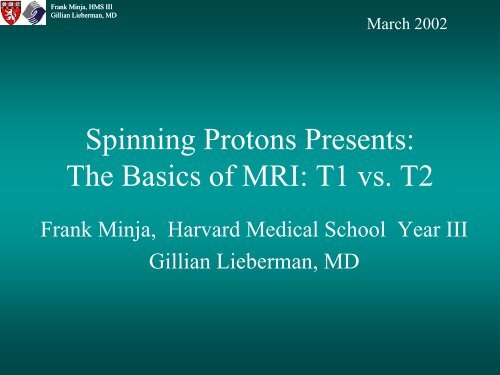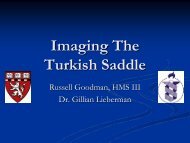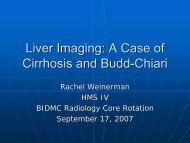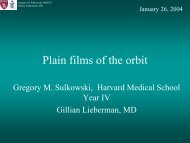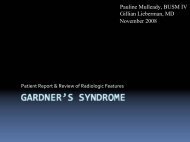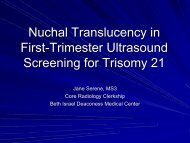The Basics of MRI: T1 vs. T2
The Basics of MRI: T1 vs. T2
The Basics of MRI: T1 vs. T2
Create successful ePaper yourself
Turn your PDF publications into a flip-book with our unique Google optimized e-Paper software.
Frank Minja, HMS III<br />
Gillian Lieberman, MD<br />
March 2002<br />
Spinning Protons Presents:<br />
<strong>The</strong> <strong>Basics</strong> <strong>of</strong> <strong>MRI</strong>: <strong>T1</strong> <strong>vs</strong>. <strong>T2</strong><br />
Frank Minja, Harvard Medical School Year III<br />
Gillian Lieberman, MD
Frank Minja, HMS III<br />
Gillian Lieberman, MD<br />
From Voxels to Spinning Protons<br />
• A Voxel is a small volume element = approx 3 mm 3<br />
• A Voxel<br />
• A proton is a single positive charge in the nucleus <strong>of</strong> an atom<br />
• A cloud <strong>of</strong> positive charge<br />
• Protons are constantly spinning about their axes<br />
• A spinning charge results in a magnetic moment<br />
• Thus, spinning protons can be thought <strong>of</strong> as tiny magnetic moments<br />
• A tiny magnetic moment<br />
2
Frank Minja, HMS III<br />
Gillian Lieberman, MD<br />
Spinning Protons a.k.a Tiny Magnetic Moments<br />
• Each magnetic moment is a vector with a finite size and direction<br />
• <strong>The</strong> net magnetic moment is the vectorial sum <strong>of</strong> these tiny magnetic<br />
moments<br />
• At random these magnetic moments cancel each other out leaving a net<br />
magnetic moment <strong>of</strong> zero<br />
• Note the protons continue to spin!<br />
• Spinning Protons a.k.a Tiny Magnetic Moments<br />
3
Frank Minja, HMS III<br />
Gillian Lieberman, MD<br />
Enter the External Magnetic Field:<br />
Alignment <strong>of</strong> Spinning Protons<br />
• <strong>The</strong> external magnetic field causes the spinning protons (tiny magnetic<br />
moments) to align themselves: parallel or anti-parallel to the external<br />
magnetic field<br />
• Parallel alignment is the low energy state<br />
• Parallel alignment<br />
• Anti-parallel alignment is a high energy state<br />
• Antiparallel alignment<br />
• More spinning protons prefer the low energy state<br />
• Thus, the net magnetic moment <strong>of</strong> all spinning protons is parallel to the<br />
external magnetic field<br />
• Net Magnetic Moment<br />
• External Magnetic Field in the z-axis<br />
4
Frank Minja, HMS III<br />
Gillian Lieberman, MD<br />
<strong>The</strong> Other Spin - Precession<br />
• <strong>The</strong> external magnetic field exerts a torque on the tiny<br />
magnetic moments causing them to precess around the<br />
vertical axis.<br />
• Thus the tiny magnetic moments, parallel or anti-parallel,<br />
are not fixed in space, but are in constant precession<br />
around the vertical axis <strong>of</strong> the external magnetic field.<br />
• <strong>The</strong> rate <strong>of</strong> precession (Larmor frequency) is proportional<br />
to the strength <strong>of</strong> the external magnetic field.<br />
• Precession around the vertical axis<br />
5
Frank Minja, HMS III<br />
Gillian Lieberman, MD<br />
A Pulse <strong>of</strong> Radi<strong>of</strong>requency<br />
• Once the tiny magnetic moments are in equilibrium with the external<br />
magnetic field, they will continue to be aligned and precess about the<br />
vertical axis.<br />
• A pulse <strong>of</strong> radi<strong>of</strong>requency (RF) will disrupt the equilibrium causing<br />
the tiny magnetic moments to fall out <strong>of</strong> alignment with the external<br />
magnetic field.<br />
• Following the RF pulse, the tiny magnetic moments will tend towards<br />
their original state <strong>of</strong> alignment and precession around the vertical axis<br />
• As the magnetic moments re-align themselves, they release energy in<br />
the form <strong>of</strong> radiowaves.<br />
• <strong>The</strong>se radiowaves are the <strong>MRI</strong> signals!<br />
• A Pulse <strong>of</strong> Radi<strong>of</strong>requency (RF)<br />
6
Frank Minja, HMS III<br />
Gillian Lieberman, MD<br />
<strong>T1</strong> relaxation<br />
• <strong>The</strong> parallel and anti-parallel magnetic moments will fall onto the<br />
transverse plane when pulsed by a 90 degree RF<br />
• <strong>The</strong> net magnetic moment aligned with the External Magnetic Field<br />
• Enter a 90 degree RF pulse<br />
• <strong>The</strong> transverse plane is a high energy state<br />
• <strong>The</strong> Magnetic moments will ‘relax’ back to the vertical plane - low<br />
energy state<br />
• <strong>T1</strong> Relaxation back to the vertical plane<br />
• <strong>The</strong> energy (radiowaves) emitted during this relaxation gives the <strong>T1</strong><br />
signal<br />
• <strong>T1</strong> relaxation curve<br />
• <strong>The</strong> net magnetic moment re-aligned with the External Field<br />
7
Frank Minja, HMS III<br />
Gillian Lieberman, MD<br />
<strong>T2</strong> decay<br />
• When the parallel and anti-parallel magnetic moments fall onto the transverse<br />
plane they continue to precess around the vertical axis<br />
• Precession about the vertical axis<br />
• At time zero, all magnetic moments are in phase -Maximum <strong>T2</strong> signal<br />
• <strong>The</strong> local environment (local magnetic fields) will cause some magnetic<br />
moments to precess faster and some to precess slower. <strong>The</strong> magnetic moments<br />
fall out-<strong>of</strong>-phase (de-phasing)<br />
• Faster forward precession<br />
• Slower forward precession (reverse precession)<br />
• Since the net magnetic moment depends on direction, as more magnetic<br />
moments fall out <strong>of</strong> phase - the more they cancel each other out - the <strong>T2</strong> signal<br />
decays. This rate <strong>of</strong> cancellation = <strong>T2</strong> decay<br />
• Complete de-phasing <strong>of</strong> magnetic moments<br />
• <strong>T2</strong> decay curve<br />
• <strong>T1</strong> RELAXATION AND <strong>T2</strong> DECAY TOGETHER (repeat again!)<br />
8
Frank Minja, HMS III<br />
Gillian Lieberman, MD<br />
Spinning Protons Are Not Equal<br />
• <strong>The</strong> have the same mass and charge<br />
9<br />
1 0 H<br />
• Each spinning proton aka tiny magnetic moment is<br />
influenced by its local magnetic environment<br />
• This local environment is the tissue!<br />
• Different tissues have different local electromagnetic<br />
environments<br />
• Different local environments cause the protons to<br />
respond differently to pulses <strong>of</strong> RF<br />
• Different reponses to RF pulses = contrast in <strong>MRI</strong><br />
• (Mass density is the basis for contrast in CT)
Frank Minja, HMS III<br />
Gillian Lieberman, MD<br />
Weighting Inequalities - RF<br />
Pulse sequences<br />
• To enhance the contrast <strong>of</strong> <strong>MRI</strong> signals we<br />
can accentuate how the aligned spinning<br />
protons experience <strong>T1</strong> relaxation and/or <strong>T2</strong><br />
decay.<br />
• <strong>T1</strong> Weighting - accentuating <strong>T1</strong> relaxation<br />
• <strong>T2</strong> Weighting - accentuating <strong>T2</strong> relaxation<br />
• Proton-density weighting - accentuating the<br />
number <strong>of</strong> protons<br />
10
Frank Minja, HMS III<br />
Gillian Lieberman, MD<br />
<strong>T1</strong> Weighting<br />
• Different tissues have different <strong>T1</strong> and <strong>T2</strong> time constants<br />
• Table <strong>of</strong> <strong>T1</strong> and <strong>T2</strong> constants<br />
• To obtain an <strong>MRI</strong> image the voxel <strong>of</strong> interest must be pulsed several<br />
times with RF.<br />
• <strong>The</strong> time in between RF pulses is the repetition time (TR).<br />
• If the repetition time is long enough, all spinning protons will re-align<br />
themselves with the vertical axis = no contrast<br />
• If the repetition time is short, some spinning protons will re-align faster<br />
than others = Bingo! contrast!<br />
• <strong>T1</strong> relaxation<br />
• 90 degree RF pulse followed by a <strong>T1</strong> signal<br />
• Thus, <strong>T1</strong> weighting = short TR (repetition time)<br />
11
Frank Minja, HMS III<br />
Gillian Lieberman, MD<br />
<strong>T2</strong> Weighting<br />
• <strong>T2</strong> is the rate <strong>of</strong> decay <strong>of</strong> precession as a result <strong>of</strong> magnetic moments<br />
falling out <strong>of</strong> phase.<br />
• This rate <strong>of</strong> decay again depends on the local environment, thus the <strong>T2</strong><br />
signal depends also on the local environment (different tissues have<br />
different <strong>T2</strong> constants)<br />
• A special pulse <strong>of</strong> RF is used to measure the <strong>T2</strong> signal. This pulse<br />
reverses the precessing magnetic moments by 180 degrees.<br />
• Reversing the plane <strong>of</strong> precession<br />
• <strong>The</strong> reversal results in an ‘echo’ signal<br />
• 180 degree RF pulse followed by an ‘echo’ <strong>T2</strong> signal<br />
• <strong>The</strong> maximal echo signal is the <strong>T2</strong> signal<br />
• <strong>The</strong> time between echoes = TE<br />
• <strong>The</strong> longer the time between echoes = the better the <strong>T2</strong> contrast<br />
• Thus, <strong>T2</strong> weighting = Long TE (Echo Time)<br />
12
Frank Minja, HMS III<br />
Gillian Lieberman, MD<br />
<strong>T1</strong> weighting <strong>vs</strong>. <strong>T2</strong> weighting<br />
TR<br />
Repetition<br />
time<br />
TE<br />
Echo time<br />
<strong>T1</strong><br />
Weighting<br />
Short Long<br />
<strong>T2</strong><br />
Weighting<br />
Short Long<br />
13
Frank Minja, HMS III<br />
Gillian Lieberman, MD<br />
• Short TR + Short TE<br />
• TR < 600ms<br />
• TE < 20 ms<br />
<strong>T1</strong> Weighting<br />
• Dark Eyeballs! (TR/TE = 450/14 ms)<br />
• Dark Eyeballs! (TR/TE = 450/14 ms)<br />
• Dark Lesion (TR/TE = 450/14 ms)<br />
• Dark Lesion (TR/TE = 450/14 ms)<br />
14
Frank Minja, HMS III<br />
Gillian Lieberman, MD<br />
• Long TR + Long TE<br />
• TR = 2000 - 3500 ms<br />
• TE = 70 - 150 ms<br />
<strong>T2</strong> Weighting<br />
• Bright Eyeballs! (TR/TE = 5500/105 ms)<br />
• Bright Eyeballs! (TR/TE = 5500/105 ms)<br />
• Bright Lesion! (TR/TE = 5500/105 ms)<br />
• Bright Lesion! (TR/TE = 5500/105 ms)<br />
15
Frank Minja, HMS III<br />
Gillian Lieberman, MD<br />
Proton (Spin) Density Weighting<br />
• <strong>The</strong> signal depends on the number <strong>of</strong> spinning protons<br />
• <strong>The</strong> greater the density <strong>of</strong> protons = the stronger the signal<br />
• <strong>The</strong> smaller the density <strong>of</strong> protons = the weaker the signal<br />
• A Long TR repetition time will blunt the <strong>T1</strong> signal<br />
• A Short TE echo time will blunt the <strong>T2</strong> signal<br />
• By default contrast must now depend on the proton density<br />
• Differences in proton density = contrast!<br />
• Proton (Spin) Density weighting = Long TR + Short TE<br />
• TR = 1500 - 3500 ms<br />
• TE = 20 -35 ms<br />
16
Frank Minja, HMS III<br />
Gillian Lieberman, MD<br />
Flow<br />
• Flow adds a fourth dimension: space in time<br />
• In moving fluids e.g Blood the spinning<br />
protons are not stationary<br />
• Thus the previous three signals: <strong>T1</strong>, <strong>T2</strong> and<br />
proton density are constantly changing at a<br />
given point in space, at a given point in time<br />
• Changing signals = contrast!<br />
• This is the basis <strong>of</strong> MR angiography<br />
17
Frank Minja, HMS III<br />
Gillian Lieberman, MD<br />
MR Angiography<br />
• MR Angiography, an example<br />
18
Frank Minja, HMS III<br />
Gillian Lieberman, MD<br />
<strong>The</strong> Fifth Element<br />
• MR contrast agents<br />
• Gadolinium (Gd) is a paramagnetic metal ion that causes<br />
fluctuating magnetic fields around protons.<br />
• Gd alters <strong>T1</strong> and <strong>T2</strong> values <strong>of</strong> tissues.<br />
• Tissues that are vascular will have a brighter signal<br />
compared to non-vascular tissues.<br />
• Difference in signal = MR contrast!!<br />
• Gd is typically chelated to lessen its toxicity.<br />
• MR contrast agents are very safe to use in patients with<br />
renal insufficiency or allergies to CT contrast<br />
19
Frank Minja, HMS III<br />
Gillian Lieberman, MD<br />
MR w/ Gadolinium contrast<br />
• Gadolinium oral contrast<br />
20
Frank Minja, HMS III<br />
Gillian Lieberman, MD<br />
<strong>The</strong> Five Elements <strong>of</strong> Contrast in<br />
• <strong>T1</strong> relaxation<br />
• <strong>T2</strong> decay<br />
• Proton density<br />
• Flow<br />
• MR Contrast agents<br />
<strong>MRI</strong><br />
21
Frank Minja, HMS III<br />
Gillian Lieberman, MD<br />
• Cost<br />
<strong>The</strong> Lesser Traits <strong>of</strong> <strong>MRI</strong><br />
• Claustrophobia<br />
• Motion artifacts<br />
• Long Image Acquisition Times<br />
22
Frank Minja, HMS III<br />
Gillian Lieberman, MD<br />
<strong>The</strong> Future <strong>of</strong> <strong>MRI</strong><br />
• Technology will gradually improve cost, claustrophobia,<br />
motion artifacts and image acquisition times.<br />
• Different RF pulse sequences will further enhance the<br />
weighting capabilities for <strong>T1</strong>,<strong>T2</strong> and proton density.<br />
• Computing power will enhance the detection and<br />
resolution <strong>of</strong> <strong>MRI</strong> signals = even better images.<br />
• Functional <strong>MRI</strong> (tumor <strong>vs</strong>. normal tissue).<br />
23
Frank Minja, HMS III<br />
Gillian Lieberman, MD<br />
• Fifty years <strong>of</strong> MR<br />
Timeline <strong>of</strong> <strong>MRI</strong><br />
• 1946 - Discovery <strong>of</strong> the MR phenomenon<br />
• 1996 - Hyperpolarized 129 Xe imaging<br />
• 2046??<br />
24
Frank Student Minja, NameHMS<br />
III<br />
Gillian Lieberman, MD<br />
References<br />
• Bushberg JT, Siebert JA, Leidholdt EM, Boone JM. Chapter 11,<br />
<strong>The</strong> Essential Physiscs <strong>of</strong> Medical Imaging, 1994.<br />
• Hornak JP http://www.cis.rit.edu/htbooks/mri<br />
• Margaret M. King, RT http://www.erads.com/mrimod.htm<br />
• Oral MR Contrast Image : http://www.utdallas.edu/~balkus/pcyc2.gif<br />
25
Frank Student Minja, NameHMS<br />
III<br />
Gillian Lieberman, MD<br />
Acknowledgements<br />
Many Thanks to<br />
Gillian Lieberman, MD<br />
Ivan Pedrosa, MD<br />
Eric Niendorf, MD<br />
Michelle Swire, MD<br />
Dan Cornfeld, MD<br />
Pamela Lepkowski<br />
Mike Larson - Media Lab<br />
Our Webmasters: Larry Barbaras and Cara Lyn D’amour<br />
26


